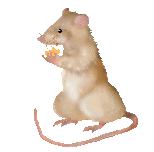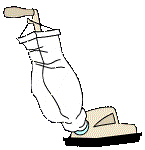

 |
|||
|
|
1. a rodent similar in appearance and behavior to a mouse, only considerably
larger. Proportionally, a rat's body is longer than a mouse's and its ears are
smaller.
![]() Back
to top
Back
to top
 Comments
CommentsThe biggest obstacle to successful rat ownership in the classroom will not
come from the students. Most students, being refreshingly open-minded, will
take one look at a domestic, or "fancy," rat and immediately become
rat advocates. Adults, however, tend to take a bit longer to overcome their
squeamishness. It's the tail that does it… for some reason, a naked tail
gives many people the willies. Of course, I've never been a fan of the hamster's
"smurf stub," so it's all in how you look at it.
Here are my tips for dealing with folks who may not be as receptive to the joys
of rathood - namely, parents and other adults.
1. Refer to rats by other names, since "rat" is an emotionally laden
word… "raffins" is common among fanciers; I use krisa or krisi
(Czech for "rat"), and students take great pleasure in finding out
how to say "rat" in other languages. Most often, my boys are just
"the class critters."
2. Prepare a flyer about the positive traits of rats for students' families
in advance… or, better yet, make a lesson out of it. I use rats as my jumping-off
point for discussions about prejudice and stereotype, and have students find
rat facts to bring in and add to our rat scrapbooks.
3. Find and acquire a color of rat that is unusual and attractive… the
poor white albinos are often trapped in the "lab rat" stereotype,
and the brown-and-black agoutis, when grown, may resemble their wild relatives
too much for some folks. Most people, however, are receptive to colors they
don't usually see on rodents… their fascination with the color will overpower
their initial reaction to "RAT."
4. Teach your rats some neat tricks for your students to show off to visitors…
people tend to be impressed by what they see as "smarts" in an animal.
Cages are best for rats, and the larger the cage, the better. Rats love to
climb, and will expend great energy playing on, in, and around their cages -
much to the delight of students. There are a myriad cage plans available for
do-it-yourself types… I made my first cage for $30, using only materials
from a local Home Depot - and it was larger and sturdier than any cage I could
have purchased for the same cost. For those who like the prepackaged variety,
there are many options as well. The vast majority of rat fanciers adore a "mom
and pop" company called Martins Cages, and purchase their cages from that
Web site. If you decide to purchase a cage from a local store, you'll want to
get one designed for a ferret, guinea pig, or a rabbit - the "rat"
cages sold by most major chains are too small to allow for ample exercise. Minimum
cage size is 14"x24"x12", according to noted rat expert Debbie
Ducommun.
Will an aquarium tank do? Yes and no. Tanks can be handy to have around - I
use a twenty gallon tank for a "hospital wing" - but in general, cages
are your best bet. Rats, as most rodents tend to be, are susceptible to a wide
variety of respiratory ailments… while aquarium-style tanks do have their
benefits (they are wonderful for keeping drafts out and bedding in), they tend
to be more difficult to clean, to transport, and may allow ammonia from urine
to accumulate in the bottom of the tank, which can aggravate breathing problems.
If you must have a tank, you should get a tank no smaller than twenty gallons
- and this ONLY for two small females. You can also build an upper story "hood"
onto a tank using powder-coated wire mesh - plans can be found on PetRats 3.0
(http://www.icubed.com/users/mfichten/rats/)
- and add space, as well as ventilation, to your rat's abode.
For the truly rat-crazy teacher with floor space to spare, the final option
is a "rat condo" made from a child's swimming pool and powder-coated
wire mesh, made popular by Debbie Ducommun's Rat Fan Club. This is ideal for
a classroom setting if you want your students to watch the rats rather than
handle them… and allows you to have a vertitable rat pack, as up to six
rats can live comfortably in such a cage! Plans are available online at the
Rat Fan Club (http://www.ratfanclub.org/).
There has been much debate over bedding. It is the opinion of most rat breeders
and fanciers that the most common and inexpensive beddings - cedar and pine
shavings - can be lethal if rats are exposed to them long-term. The wood oils
that make these shavings pleasant to smell emit hydrocarbons that can cause
health problems for rats in terms of liver disease, handicapped immune systems,
and respiratory infections. Use aspen shavings or commercially prepared beddings
like CareFresh or recycled paper pellets.
Cages should be supplied with a sleeping shelter (a large PVC pipe "joint"
will do nicely), a heavy ceramic food dish, a hanging water bottle, and toys
such as ladders, climbing ropes, cardboard tubes, and boxes. Many toys made
for parrots are also suitable for rats, and I do a good bit of supply shopping
at my local bird supply store. Rats also love toys and cage furnishings made
for ferrets - especially hammocks! I can't keep my boys out of them.
![]() Back
to top
Back
to top
Rat blocks are a staple to any healthy rat's diet, though some owners feed
Nutro Lite dog food because of the balance of nutrition. There are also specific
"rat mixes" available - Rodney Rat is a grand one, though expensive
- but some rats will pick out their favorite parts and leave the rest!
A staple diet should be supplemented by a variety of fresh fruits and vegetables
daily, with weekly protein treats - my boys like boiled egg, cold cuts, cooked
chicken, shrimp, and steak. Rats will happily eat anything people eat, but such
treats should be given only in moderation. There are a number of web sites which
offer different rat menus for owners to choose from. Rats are also mad for sunflower
and pumpkin seeds, as well as peanuts (unsalted). Don't overdo it on the seeds…
they make a rat chubby!
Fresh water and wood chews for gnawing are not food sources, but are essential
to maintaining a rat's health.
![]() Back
to top
Back
to top
 Maintenance
MaintenanceWeekly cleaning is a must… a clean rat cage doesn't smell! Empty all litter
and disinfect the cage and surfaces rats play and sleep on, but don't use PineSol
or pine-based cleaners. I use antibacterial dish soap and water, though other
products are available.
Change food and water daily, particularly if your water bottle is plastic -
plastic bottles, for some reason, are more prone to bacterial growth. Wash dishes
and bottles thoroughly at least once a week. Stick any cloth furnishings like
hammocks in the washer once a week, too.
Rats are members of the rodent order of mammals, including guinea pigs, gerbils,
mice, squirrels, and beavers. Like all mammals, they give birth to live young
and nurse with milk. Rodents have continuously growing front incisor teeth,
which is why they are always gnawing.
Rats have a long history in association with humans, though not always pleasant.
While many cultures regard rats benevolently - they are the first sign in the
Chinese Zodiac, and a Hindu god - Western Europeans thought of them as "the
devil's lapdog" and creatures of darkenss, death, and disease. Rats were
wrongly blamed for transmitting the Black Plague… it was actually the fleas
on the rats which carried the deadly illness. Rats were simply handy transport
for the blood-sucking insects. In ages past, rats were used in bloodsports…
terriers were thrown down into pits filled with hundreds of rats, and were timed
to see how many rats could be killed in a set time period.
In scientific arenas, rats have been found handy as laboratory animals, and
have been instrumental in the discovery of cures for a wide range of diseases
once thought to be incurable. Even today, the humble lab rat serves out its
short life in pursuit of cures for AIDS, cancer, and many mental illnesses.
As pets, all fancy rats are descended from the Norway Rat, rattus norvegicus
- the same rats found on the streets of cities and in the fields of rural areas.
Bred in Victorian times as pets for young ladies, they have been doted upon
by the likes of Beatrix Potter, who dedicated a book to her pet raffin, and
other celebrities through the years. Theodore Roosevelt's household included
pet rats, as does the home of British comedian John Cleese.
What can you expect from rats as a classroom pet? Plenty! Rats are the closest
a classroom pet can come to having a resident dog… rats are intelligent,
affectionate, and bond strongly with their humans due to their social nature.
Unfortunately, the vast majority of people have the image of the "two foot
long subway rat" of urban legend firmly implanted in their minds, and simply
refuse to see the difference between a wild rat and its domestic cousin.
Wild rats can be all that folk legend has made them out to be… but not
because they're evil. Rats are simply mid-level predators, and humans have created
ideal habitats for them in our cities and dumps. Fancy rats, on the other hand,
are as different from their wild cousins as, say, Cocker Spaniels are from coyotes.
Fancy rats come in a mystical array of colors. Most folks know the pink-eyed
whites (called PEWs on many fancier sites), the "wild color" called
agouti (brown with black ticking), and the "hooded" varitety (picture
a rat dipped in black, brown, or tan paint up to its shoulders, with the rest
of the body white). More exotic colors exist, with an array of markings that
would do any artist proud… my own rats are lilac (a pale dove gray, with
brown overtones), champagne (a faint silvery beige), and what seems to be either
"silvered black" (black with silver hairs) or chocolate brown. "Blue"
is an extremely popular color among fanciers - a lovely silver is what it looks
like to laypersons - as well as fawn, Siamese (cream and brown, like the cat),
and a new color scheme called "husky" (intended to mimic the colors
and patterns of sled dogs).
Then there are the hairless rats, the "rex" rats (think rats in poodle
coats), the dumbo rats (rats with larger ears set lower to the head, making
them look rather like plush toys - very sweet!), and even rats who lack a tail.
All make wonderful pets.
 Characteristics
Characteristics(This booklist was taken directly from the booklist compiled by the AFRMA. These references, and more like them, can be found at the AFRMA website below.)
NONFICTION
· The Proper Care of Fancy Rats by Nick Mays. 1993. T.F.H. Publications,
Inc., NJ. A very good book.
· Rats - For Today's Pet Owner From the Publishers of Critters Magazine
by Debbie Ducommun. 1998. Bow Tie Press, Irvine, CA. A very good pet owner's
book.
· Fuzzy Creatures Quarterly RATS - Selection, Handling, Feeding, Housing
also labeled as RATS A Complete Introduction by Daniel R. Schwartz, M.S., D.V.M.
1997. T.F.H. Publications, Inc., Ltd., NJ. A very good book.
· Rats - A Complete Pet Owner's Manual by Carol A. Himsel, D.V.M. 1991.
Barron's, New York. A very good book.
· The Rat (An Owner's Guide to a Happy Healthy Pet Series) by Ginger
Cardinal. 1998. Howell Book House, A Simon & Schuster Macmillan Company,
NY.
· Guide to Owning a Rat - Housing, Feeding, Taming, Training, Breeding,
Health by Susan Fox. 1996. T.F.H. Publications, Inc., NJ.
· Rats by Susan Fox. 1983. T.F.H. Publications, Inc., Ltd., NJ.
· Rats For Those Who Care by Dennis Kelsey-Wood. 1995. T.F.H. Publications,
Inc., NJ.
· All About Your Rat by Bradley Viner. 1998. Barron's. New York.
· All About Rats by Howard Hirschorn. 1974. T.F.H. Publications, Inc.,
NJ.
· Mice and Rats by K.W. Smith. 1976. John Bartholomew & Son Limited,
Edinburgh.
· Hamsters and Gerbils by David Alderton. 1986. Tetra Press. Contains
information on mice, rats and chinchillas as well.
· Guinea Pigs and Other Laboratory Animals by Gloria R. Mosesson and
Sheldon Scher. T.F.H. Publications, Inc., NJ.
· Small Pets by Joan Palmer. 1983. Blandford Press, Poole Dorset and
Sterling Publishing Co., Inc., New York.
· Rabbits and Other Furry Pets by Elizabeth Randolph. 1992. Ballantine
Books, NY.
· Small Pet Handbook - A Family Guide to Buying, Caring For, and Breeding
Small Pets (Rats & Mice, Hamsters, Gerbils, Guinea Pigs, Rabbits) by David
Taylor, BVMS, FRCVS, FZS. 1997. Barron's, New York.
· Enjoy Your Gerbils, Rats and Mice by Helen Perley. The Pet Library
Ltd., New York.
American Fancy Rat and Mouse Association
http://www.afrma.org/
- An especially helpful site; check out the Kid's Korner for downloadable coloring
pages, puzzles, and rat information!
Rat and Mouse Club of America
http://www.rmca.org/
- Another well-detailed site, aimed more at adults than children, stocked with
a plethora of articles and helpful links. For teachers who enjoy a good read-aloud,
check out "The Mouse Knight," an online novel written and illustrated
by RMCA member Cutter Hays. My sixth graders loved it!
The Rat Fan Club
http://www.ratfanclub.org/
- This club was founded by Debbie Ducommun, "The Rat Lady" herself.
(You can see Debbie featured in a spot on pet rats if you can catch "Nigel's
Wild Wild World: Rats" on Discovery Channel.) The message board is where
I've met several other rat-owning teachers; it's very handy for posting questions
about your new raffins.
| Getting around in this Web site |
This page created July 2002.